
WHO'D HAVE THOUGHT that wood-fired motoring would never catch on.
Sun power
 A MELBOURNE car magazine piece from 1954 asked the question: “Does this mean General Motors already has a sun motor working in its laboratories?”
A MELBOURNE car magazine piece from 1954 asked the question: “Does this mean General Motors already has a sun motor working in its laboratories?”
Then provided the answer: “More likely yes than no.” Hmm.
The same article also predicted that by 1965, American cars would be tear-drop in shape, use radar for navigation, be made from a combination of titanium, aluminum, magnesium and plastic and be powered by a rear-mounted gas turbine engine.
It's easy to see how such a prediction was made given the rapid technological development of the car – and of course other aspects of technology, such as flight – in the previous decades.
GM was trying to crack the ‘sun power’ nut.
Respected engineer Charles Kettering, who was head of research at GM from 1920 to 1947, was hung up on mimicking the way nature turned solar radiation into energy using chlorophyll as a catalyst. To this day, scientists are still getting headaches trying to make solar energy from organic compounds.
However, Kettering also acknowledged other proposals at the time, including the direct conversion of solar to electrical energy using the photoelectric cell. This is the technology used for modern solar panels. A large unit fitted to a house can generate enough energy to fully charge an electric car.
Experimental solar race cars aside, the idea of a vehicle powered by onboard solar doesn’t quite pass the reality test.
THE GOOD: A catchy name for a sun-powered car would be the Solarium. Wait, scratch that.
THE BAD: Giant roof-mounted panels wouldn’t be so great navigating a Maccas drive-through.
4/10
Steam power
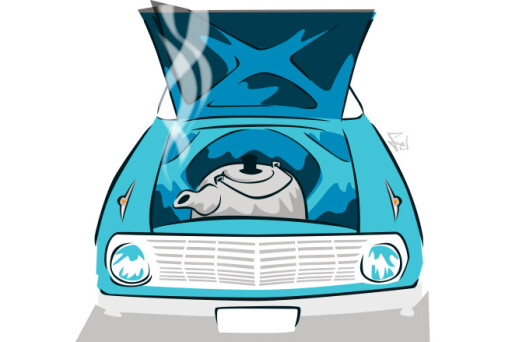 DESPITE the best efforts of a talented Melbourne engineer, steam-engined cars have been missing from showrooms since the 1920s.
DESPITE the best efforts of a talented Melbourne engineer, steam-engined cars have been missing from showrooms since the 1920s.
From 1899 to 1905, the Stanley Steamer outsold petrol cars, though it was outsold by the electric vehicles of the Columbia Automobile Company. A Stanley also set a new land speed record of 204km/h on Ormond Beach, California in 1906.
But by 1924 the Stanley car company (and most other steam car producers) had folded, beaten by good old gasoline.
There have been several attempts to reintroduce steam as an alternative to petrol.
In the early 1970s, Melbourne’s Ted Pritchard fitted a 1963 Falcon with a garage lab steam-powered driveline. It had a boiler in the engine bay that could be heated by any reasonably flammable liquid fuel including sump oil, ethanol, diesel and petrol.
The power pushed the pistons in a V-twin engine, which was linked directly to the driveshaft. There was no gearbox.
In 1972, the prototype was flown to Los Angeles, where the big American carmakers tested it and appeared impressed.
However, when the oil crisis eased, oil prices slumped and motivation to take on new technology was gone.
Pritchard continued trying to raise enough money and interest to make his invention a reality up until 1980, but it never happened.
THE GOOD: Supporters say it burns cleaner than petrol.
THE BAD: Aussie prototype was impressive, but we’ll never know if it would have worked as a production model.
6/10
Wood power
 THE fuel of choice for Cletus and Co, wood gas engines have failed to find mainstream acceptance in times of peace and prosperity.
THE fuel of choice for Cletus and Co, wood gas engines have failed to find mainstream acceptance in times of peace and prosperity.
Spotting a wood gas vehicle on the road generally means your country is going through temporary trouble or, quite simply, is rooted.
The technology was most widely used during World War 2 in the UK, US and Germany, when all the available oil was being used to build and power fighting machines.
Alternatively some very poor countries have turned to wood gas when other fuels couldn’t be relied on or remained too expensive. Some regions in China used wood-burning buses into the 1990s.
The system works by burning small pieces of wood and creating gasses such as atmospheric nitrogen, hydrogen, methane and carbon monoxide, which can then be treated and used to power a traditional internal-combustion engine. The burner generally needs to be very large and they are often fitted to the tubs of pick-up trucks, leaving little room for other gear.
Wood gas engines have been promoted by the environmentally conscious, given they can burn more cleanly than most fossil fuels, although trees are chopped down to make them run.
And, if the systems fail, occupants can be exposed to high levels of carbon monoxide, which can be unpleasant. And deadly.
THE GOOD: The government can’t tax wood like it taxes petrol and diesel, can it?
THE BAD: Starting any fire is hard enough, let alone one that determines whether a car will tick over.
5/10
Nuclear power
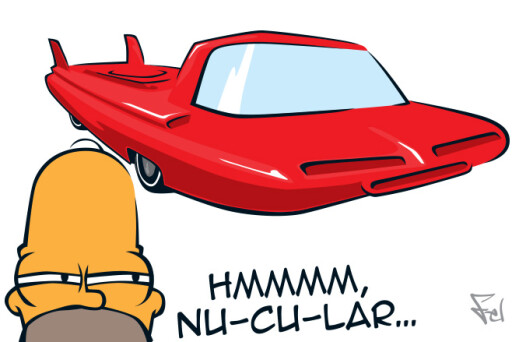 YES, small nuclear reactors were once considered future powerplants for cars. Perhaps whole towns would be obliterated following a minor nose to tail, but imagine the fuel economy!
YES, small nuclear reactors were once considered future powerplants for cars. Perhaps whole towns would be obliterated following a minor nose to tail, but imagine the fuel economy!
It seems laughable now, but in the mid-1950s, nuclear-powered cars didn’t seem quite so crazy.
Just one decade after the Americans dropped an atomic bomb on Hiroshima in Japan, a nuclear reactor was employed to power a US submarine called Nautilus. Unlike conventional diesel-electric subs, it didn’t need to surface for fuel and was super-fast thanks to its abundance of power. Today, six nations have nuclear-powered submarines. Australia, with its diesel-engined Collins Class subs, doesn’t, which is probably a good thing.
Next up, the US Air Force bunged a couple of reactors into a B-36 to create a super long-range bomber. As Car magazine explained: “The next step is obviously for automobiles.”
Ford either thought the idea had merit or simply had a good sense of humour when it revealed the Nucleon concept car in 1958. Instead of having a boring
non-apocalyptic combustion engine, it had a small nuclear reactor in the back.
The Nucleon didn’t make it into production. Neither did the nuclear-powered bomber. It was cancelled, not due to concerns for mankind, but simply because the US and Russia developed intercontinental ballistic missiles that were far better at wreaking nuclear destruction from afar.
THE GOOD: Never having to stop, except maybe to go to the toilet.
THE BAD: The possibility of a nuclear apocalypse destroying humankind as we know it.
1/10
Methane power
 BIOGAS has been around forever, as gassy cavemen would have found out rather quickly if they sat too close to the fire.
BIOGAS has been around forever, as gassy cavemen would have found out rather quickly if they sat too close to the fire.
More recently, we discovered the same type of gasses (which are rather unpleasant when released inside a car’s confines) can also be used to propel the vehicle when fed into its engine.
But people have known for some time that gas produced from various bits of stinky matter could be used as a fuel. There is evidence that biogas was used to heat bath water in Assyria (a region that contained northern Iraq, north-eastern Syria and south-eastern Turkey) in the 10th century BC.
The Brits worked out that the gas created during the sewage treatment process could be used for various purposes; it was employed to power the street lights in Exeter from 1895.
It also appears American inventors started experimenting with biogas as a fuel for combustion engines during the 1930s, along with regular compressed natural gas (CNG), which is a gas refined from fossil fuels rather one generated from smelly matter.
Europe has always been big on the gas and motorists in several countries including Sweden, Switzerland and Germany use biogas regularly.
THE GOOD: Super clean because burning it doesn’t actually increase the carbon dioxide in
the environment.
THE BAD: Some poor bastards have to collect it.
8/10
Coal power
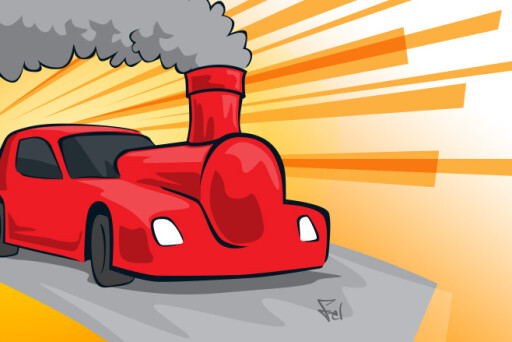 PRIME Minister Tony Abbott (at the time of writing, at least) once declared that coal was “good for humanity”. Well, we’ll choose to leave that one alone but it could be good for powering your car, should Australia’s fuel imports ever be cut off.
PRIME Minister Tony Abbott (at the time of writing, at least) once declared that coal was “good for humanity”. Well, we’ll choose to leave that one alone but it could be good for powering your car, should Australia’s fuel imports ever be cut off.
Technically, coal-powered cars are on sale now, with much of the grid power used to charge electric cars like the Nissan Leaf and BMW i3 generated by dirty coal.
Once there were cars that used coal directly, burnt aboard the car itself to fuel the engine. Some of the earliest cars used coal or kerosene to fire steam engines.
From time to time, coal was used in engines similar to wood-fired engines. The idea is that the coal produces gas, which can then be burnt in a converted combustion engine.
Interestingly, the son of the founder of Cummins claimed that Rudolf Diesel – inventor of the diesel engine – initially tried to use coal dust in the combustion chamber of his engine. It blew up.
Now it has been reported that cars burning “clean coal pellets” could soon be a reality. Sane people have dismissed the idea, pointing out that, even if it did burn cleanly, it would still produce a poisonous solid ash.
THE GOOD:We certainly have plenty of the stuff here in Australia.
THE BAD: Choking the planet.
2/10
Fuel cell power
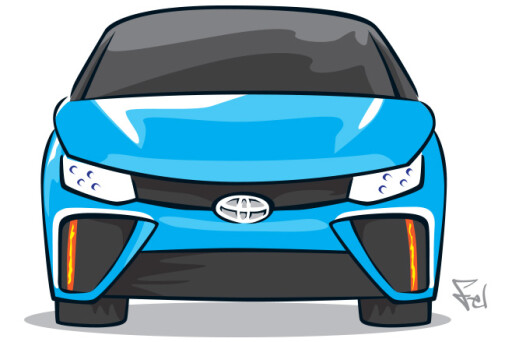 If you follow the progress of engine technology, you’re probably sick of hearing about the potential of fuel cells.
If you follow the progress of engine technology, you’re probably sick of hearing about the potential of fuel cells.
Countless car companies have produced futuristic concept vehicles with supposed fuel cell powerplants for more than a decade, but fuel cell vehicles are still not produced in any meaningful volume.
The idea is tantalising. Just bung in some hydrogen and out pops some electricity to drive your wheels. With steam the only byproduct, there are no nasty exhaust emissions (although the hydrogen production process can produce them).
Fuel cells make power using a chemical reaction that turns hydrogen and oxygen into heat and electricity. Electrical energy is unlocked directly from chemicals, unlike fossil fuels and the relatively inefficient refining and combustion process.
The fuel cell concept dates back to the 1830s, and in the 1960s, NASA used them for the US space program. Even so, fuel cell cars are still not produced in any meaningful volume.
Hyundai and Toyota each offer one, but only produce a handful of them, while fuel cell buses, forklifts, boats and submarines are currently in service in pilot programs, though none have proven to be cost-effective.
Issues include the cost of the fuel stacks, problems with on-board hydrogen storage and a massive refuelling infrastructure.
THE GOOD: Super-efficient and near silent energy production.
THE BAD: It may never, ever be cost-effective.
6/10
Air power
 Using compressed air to propel a car makes sense to anyone who has let go of a balloon before tying the knot.
Using compressed air to propel a car makes sense to anyone who has let go of a balloon before tying the knot.
It also makes an amusing noise that would sound great coming out a great big exhaust pipe on a P-platers’ pride and joy.
Several engineers have been working on air engines for nearly a century, including Melbourne’s Angelo di Pietro, but the technology has not progressed into production.
Compressed air was used from the late 1800s to propel some trains and trams where fossil fuel emissions would have been problematic – such as underground mines – but were soon replaced by electric models.
Compressed air has a very low energy density and developers have not worked out a practical way to give a car the kind of range needed to be taken seriously for general use.
However, there is still a chance for compressed air with the pneumatic hybrid concept, which PSA Peugeot-Citroen thinks could soon be a reality.
This hybrid concept has a regular combustion engine, but harvests electricity (like a petrol-electric hybrid). Instead of being stored in a battery, the energy is used to compress air in a tank. The air can then be used to power the engine at lower speeds.
THE GOOD: A hybrid that might actually be worthwhile.
THE BAD: Poor range, unless used as a hybrid with a combustion engine.
5/10
Turbine power
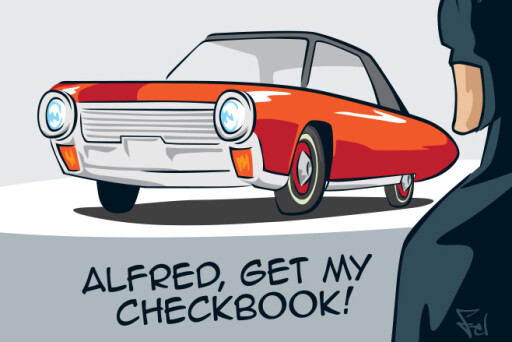 Think your VTEC Honda can rev? Check out Chrysler’s gas turbine, which had a maximum engine speed of 44,500rpm.
Think your VTEC Honda can rev? Check out Chrysler’s gas turbine, which had a maximum engine speed of 44,500rpm.
The 1962 Chrysler Turbine Car is the only vehicle to be produced and released into the hands of the public, though just 50 were allowed out on trial.
The turbines could run on pretty much anything, from jet fuel to diesel and vegetable oil, although they had a problem with leaded petrol, which was the common fuel of the day. Chrysler claims the Mexican president, who was loaned a prototype, successfully ran it on tequila.
The turbine engines had 80 percent fewer parts, didn’t need tune ups or oil changes, were light, didn’t need to warm up, ran smoothly and delivered good performance, though took some time to spool up and the lag bothered some customers.
Chrysler finally killed the project in the late 1970s, partly because the US government pulled much-needed funding, but also because it sucked fuel, was expensive to build and the exhaust was red hot.
Gas turbines could make a comeback with plug-in hybrids, with GM engineers saying in 2010 the technology would be great for charging the battery. Later that year, Jaguar presented the CX-75 concept, which used two mini-turbines that charged its batteries. Unfortunately, it was killed off when Jaguar realised it had no money.
THE GOOD: The more revolutions the better. Che Guevara would be proud.
THE BAD: Engineers would have to solve the noise issue. It was said to sound like a big vacuum cleaner.
7/10
Rocket power
 Have you ever thought: “I should strap a solid fuel rocket to my car”? Well, it turns out some slightly mental blokes have done just that on occasion.
Have you ever thought: “I should strap a solid fuel rocket to my car”? Well, it turns out some slightly mental blokes have done just that on occasion.
The most infamous solid rocket car story emerged in 1995, spreading around the internet (then known as the Information Super Highway, rather than the Porn and Spam and Videos of Cats Super Highway that it has become). Its fame was heightened when given the celebrated Darwin Award that champions the deaths of stupid people in the name of evolution.
Apparently a retired US Air Force sergeant managed to get hold of a solid-fuel rocket used to help heavy planes lift off from short runways and strapped it to his 1967 Chevrolet Impala on a remote road in Arizona.
The story goes that when he lit the candle, the car reached a terminal velocity of 480km/h before taking off, soaring like an eagle (strapped to a rocket) before slamming into a mountain. Unfortunately (or fortunately?) it was all a big hoax.
However, the British Bloodhound team is very real and is preparing a land speed record racer that uses a jet engine and a hybrid solid fuel rocket, with a Cosworth F1 V8 just to pump in the oxidizing agent. Thankfully it can be shut off at any time.
THE GOOD: Stunning acceleration.
THE BAD: The possibility of unscheduled flight.
2/10
Water power
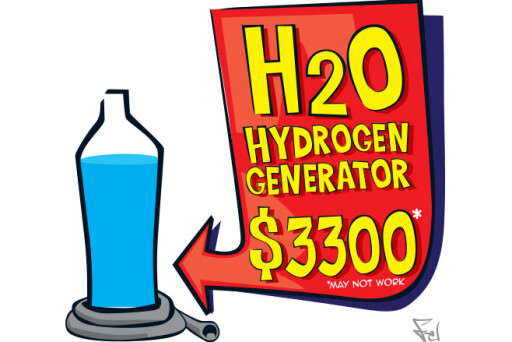 Water is great for many things, but powering a car is not one of them. Not that this has stopped a series of people, many of whom fit the “dodgy-as” profile, claiming to have come up with a miracle invention that turns water into fuel.
Water is great for many things, but powering a car is not one of them. Not that this has stopped a series of people, many of whom fit the “dodgy-as” profile, claiming to have come up with a miracle invention that turns water into fuel.
An actual water engine was used in London during the 19th century, using the water pressure from the mains water to drive an engine (with valves and everything) that operated machines like cranes and water pumps. But that isn’t going to work for your Commodore.
Water can also be treated in order to extract hydrogen, which can be used in a modified combustion engine or put through a chemical reaction in order to generate electricity in a fuel cell, but that system is complex and expensive.
However, an American preacher-salesman-inventor (yes, you should be worried already) by the name of Dennis Lee has clearly out-done the car companies, coming up with the incredible HHO Hydrogen Generator that turns water into hydrogen, which can then be fed into the engine and cuts fuel consumption by more than
50 percent. Genius.
You can have one installed for about $3300 or become a dealer for just $330,000. US news outlet NBC, described by Lee as an “oil company stooge”, did an independent test and found the device simply didn’t work.
THE GOOD: Promises to cut your fuel bills by more than 50 percent.
THE BAD: Doesn’t actually work.
0/10
Ethanol power
 The Brazilians love ethanol. But then they also like to painfully wax their nether regions.
The Brazilians love ethanol. But then they also like to painfully wax their nether regions.
As for the rest of the world, we’re not so sure – about the fuel, that is, not the hair business.
Ethanol is a form of alcohol, which is good, but when used in most engines made before the late 1990s, it corrodes some of the components, which is bad.
In Brazil, most vehicles run on at least 20 percent ethanol, but many use 100 percent.
The 40-year ethanol push is all about utilising Brazil’s massive sugar cane industry because, try as we might, the world can only eat so much sugar.
Now the North Americans are turning to ethanol because it can also be made from corn, and the US has many corn farmers. Then there is the added benefit of reducing America’s reliance on imported oil, which means it doesn’t have to invade as many Middle Eastern countries, unless it wants to.
But Ethanol production is contentious, with critics arguing that crops grown for food could soon be replaced by crops grown for fuel.
Used in blends of up to 85 percent in Australia, ethanol has a higher octane rating than petrol, but less energy per drop, which results in higher fuel use.
Don’t expect to see ethanol use surge here as there are only a handful of producers in Australia.
THE GOOD: Simple enough to make at home in an alcohol still.
THE BAD: Alcohol is for solving human problems, not car problems.
6/10
Sign up here to receive the latest round-up of Wheels news, reviews and video highlights straight to your inbox each week.

COMMENTS